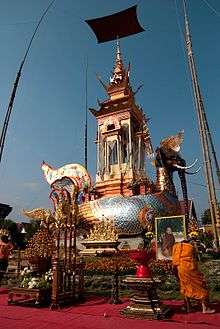Hatsadiling
Hatsadiling (Thai: หัสดีลิงค์; Burmese: ဟတ္ထီလိင်္ဂ; Pali: hatthīliṅga; Sanskrit: hastilinga) is a mythical bird commonly featured in Northern Thai art. The hatsadiling is considered to be the size of a house, with the head and body of a lion, trunk and tusks of an elephant, the comb of a cock, and the wings of a bird.[1] According to an oral myth in northeastern Thailand, the bird once inhabited the legendary forest of Himavanta.[2] The bird is often featured as a motif on funerary hearses of prominent Buddhist monks in Northern Thailand during phongyibyan cremation ceremonies.[2] The hatsadiling (hathi linga) has also been used by the Marma people as a primary motif for funerary hearses.[3]

The bird was considered instrumental in the founding of Hariphunchai, a Mon kingdom in modern-day Thailand.[1] It is featured in Cāmadevivaṃsa, a Pali chronicle that recounts the founding of the Hariphunchai kingdom by Queen Camadevi.[4] The Dhammapada-aṭṭhakathā mentions the hastilinga.[5] Buddhaghoṣa mentions it as an animal which possesses the strength of five elephants.[5]
Other terms
In the Thai language, the bird is also known by a number of terms, including nok hatstadiling (นกหัสดีลิงค์), nok hatsading (นกหัสดิน), nok hatsadi (นกหัสดี) and nok hat.
References
- Stratton, Carol (2004). Buddhist Sculpture of Northern Thailand. Serindia Publications, Inc. ISBN 9781932476095.
- Baker, Christopher John (2004). The Society of Siam: Selected Articles on the Siam Society's Centenary. Siam Society. ISBN 9789749210666.
- Hutchinson, Robert Henry Sneyd (1906). An Account of the Chittagong Hill Tracts. Bengal Secretariat Book Depot. p. 122.
hathi linga.
- Bodhiraṅsī; Swearer, Donald K.; Premchit, Sommai (1998-05-28). The Legend of Queen Cama: Bodhiramsi's Camadevivamsa, a Translation and Commentary. SUNY Press. ISBN 9780791437766.
- "Fourth Chapter - Compare Between the Dhammapada and Tirukkal" (PDF).